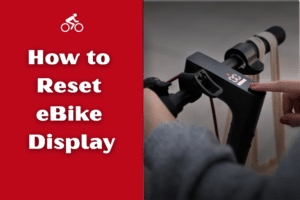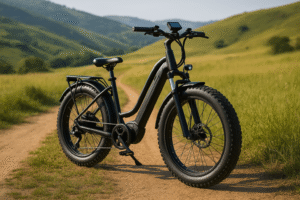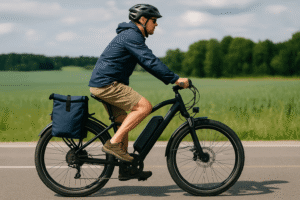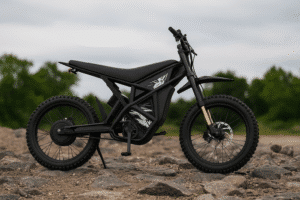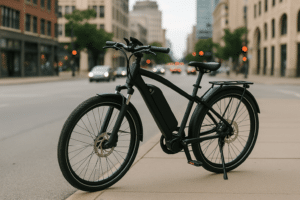California e-bike laws have changed in 2025, and if you ride or plan to buy an electric bike in the state, there are some important updates to know.
From throttle restrictions to motor power limits, the rules now make a sharper distinction between e-bikes and motorized vehicles.
These updates affect all three e-bike classes and apply to riders, sellers, and rental operators.
Whether you’re commuting to work or just cruising for fun, knowing the law will help you avoid tickets and ride safely.
TL;DR
In California, e-bikes are mostly treated like regular bicycles but must follow rules on speed, motor power, and safety gear. You don’t need a license, insurance, or registration to ride a legal e-bike, but you must follow traffic laws and class-specific restrictions. Throttles are only allowed on Class 2 bikes, and all riders under 18 must wear helmets. Class 3 bikes are for riders 16 and up and are limited to pedal assist only.
Key e-bike rules in California:
- Age Limit: You must be 16 or older to ride a Class 3 e-bike.
- Helmets: Required for anyone under 18 and for all Class 3 riders.
- Speed Limits: Class 1 and 2 cap at 20 mph; Class 3 caps at 28 mph.
- Motor Power: All e-bikes must stay under 750 watts.
- Throttles: Only allowed on Class 2 e-bikes (up to 20 mph).
- No Registration Needed: No license, plates, or insurance required.
- Where You Can Ride: Class 1 and 2 allowed on most paths; Class 3 restricted to roads or specific lanes.
- Local Rules May Vary: Cities and counties can set their own trail or sidewalk rules.
New Rules for Electric Bikes in California (2025 Update)
California has introduced new e-bike regulations that went into effect in 2025. These rules apply to how e-bikes are classified, powered, and ridden.
- Throttles are banned on Class 1 and Class 3 e-bikes. These bikes must be pedal-assist only, meaning you have to pedal to get motor support.
- Class 2 e-bikes can still use throttles but only up to 20 mph. If you’re not pedaling, the motor will stop helping after that speed.
- All e-bikes must have a motor under 750 watts. This keeps electric bikes from being as powerful as mopeds or motorcycles.
- Battery safety rules are now in place. By 2026, all e-bike batteries must be certified for safety.
- Rental companies must comply by 2028. They can’t rent out e-bikes unless both the bike and battery are certified.
- Helmet laws remain strict. Riders under 18 must wear helmets. For Class 3 bikes, helmets are required no matter your age.
- You must be 16 or older to ride a Class 3 e-bike. This hasn’t changed, but it’s now being more strictly enforced.
E-Bike Classes in California: Class 1, 2, and 3 Explained
There are three official California e-bike classes. Each class is based on how the motor works, how fast the bike can go, and whether a throttle is allowed.
What Makes an E-Bike a Class 1, Class 2, or Class 3?
Class 1 e-bikes provide pedal-assist up to 20 mph, Class 2 e-bikes offer throttle and pedal-assist up to 20 mph, and Class 3 e-bikes provide pedal-assist only up to 28 mph.
- Class 1: These bikes only give you motor assistance when you pedal. Once you hit 20 mph, the motor cuts off. They are good for city riding and bike paths.
- Class 2: These have a throttle, which means you can use motor power without pedaling. The throttle and pedal-assist both stop at 20 mph.
- Class 3: These bikes offer pedal-assist up to 28 mph but can’t have a throttle under the new 2025 laws. They must also come with a speedometer.
Which E-Bike Class Can Have a Throttle?
Only Class 2 e-bikes can legally have a throttle in California. Class 1 and Class 3 bikes must be pedal-assist only.
This is one of the most important updates. In the past, some Class 3 bikes had throttles, but that’s no longer allowed. The law now clearly separates throttle-equipped bikes into Class 2 only. If your bike has a throttle and goes above 20 mph, it could be considered illegal.
Where Can Each Class Be Ridden Legally?
Class 1 and 2 e-bikes can be ridden on most bike paths and lanes. Class 3 bikes are limited to roads and on-street bike lanes unless local laws say otherwise.
Local cities and counties can decide where Class 3 bikes are allowed. Class 1 and Class 2 bikes are more widely accepted on shared-use paths, parks, and trails. If you’re unsure, look for posted signs or check local ordinances.
Can You Switch Between Class Settings?
No, switching between e-bike classes using apps or software is not legally allowed in California. Your e-bike must match its permanent label and class.
California law requires all e-bikes to have a permanent label showing the class, top assisted speed, and motor wattage.
Changing these settings after purchase, or using an app to boost speed or power, can make your bike non-compliant. That could result in fines or your e-bike being considered an unregistered motor vehicle.
Are Throttles Still Legal on Electric Bikes in California?
Only Class 2 e-bikes can legally have a throttle in California. Class 1 and Class 3 bikes must be pedal-assist only, with no throttle allowed.
This is one of the biggest changes in the 2025 California e-bike laws. Class 1 and Class 3 e-bikes are now required to operate only through pedal assistance. Even if the bike used to include a throttle, it’s no longer allowed under the updated rules.
For riders who want throttle control, Class 2 electric bikes are the only legal option. These bikes can use a throttle to reach speeds up to 20 mph.
If you’re caught using a throttle on a Class 3 e-bike in California, you may face fines or have your bike classified as a non-compliant motor vehicle.
California E-Bike Speed Limits and Power Restrictions
The speed limit for Class 1 and 2 e-bikes is 20 mph, while Class 3 e-bikes can go up to 28 mph, but only with pedal assist.
California separates e-bike speeds by class. Class 1 and Class 2 bikes stop motor assistance at 20 mph.
Class 3 e-bikes can assist up to 28 mph, but you must be pedaling to reach that speed, and throttles are not allowed. These rules help keep ebike speed limits in California consistent with traffic safety.
All electric bikes must also comply with the 750-watt power limit. This means the motor can’t deliver more than 750 watts of sustained power.
Bikes with stronger motors fall into moped or motorcycle territory, which comes with more legal requirements like insurance and registration.
Some riders use apps or unlock settings to boost speed, but doing that is not allowed under California e-bike law.
If your bike exceeds its class speed or power limit, even with mods, it’s considered illegal. You could face fines, insurance issues, or have your bike taken off the road.
Battery Safety Rules for California E-Bikes
Starting January 1, 2026, all e-bike batteries sold in California must be certified for safety by an accredited lab.
This is part of a bigger push under the California electric bike laws to reduce fire risks and improve battery reliability.
E-bike batteries can be dangerous if poorly made or improperly charged. Certification ensures that the battery meets national safety standards and reduces the risk of accidents.
These rules apply to new sales, but rental companies must follow additional steps. By 2028, e-bike rental companies in California won’t be allowed to rent bikes unless both the bike and the battery are certified. That includes companies offering short-term rentals or tourist rides.
These changes are part of a broader effort to make e-bike use in California safer and more standardized.
If you’re buying a new bike, especially from a lesser-known brand, make sure it comes with a battery that meets these new rules. It’s not just about compliance, it’s about staying safe while you ride.
Where Can You Legally Ride an Electric Bike in California?
In California, you can ride Class 1 and 2 e-bikes on most bike paths and trails. Class 3 e-bikes are usually limited to roads and designated bike lanes.
Under current electric bike rules in California, Class 1 and Class 2 bikes are treated much like regular bicycles.
You can use them on shared-use paths, park trails, and most bike lanes unless a local rule says otherwise. However, riding on sidewalks is often restricted and varies from city to city.
Class 3 e-bikes have more limits. Since they can go up to 28 mph, they are typically restricted to roadways, on-street bike lanes, or specific paved paths next to roads.
They can’t be used on hiking trails, equestrian paths, or certain off-road routes unless the trail is connected to a street and local signage allows it.
Local laws matter. Cities and counties have the power to restrict or expand where e-bikes can go. Always check signs or city websites before riding in unfamiliar areas. The bike rules in California can vary more than most riders expect.
What Age Do You Need to Be to Ride an E-Bike in California?
You must be at least 16 years old to ride a Class 3 e-bike in California. There is no minimum age for Class 1 and 2 bikes, but riders under 18 must wear a helmet.
This is the standard electric bike age limit in California. For higher-speed Class 3 bikes, the law is clear—no one under 16 can ride them, even if supervised. Class 1 and 2 bikes are more flexible, and many families use them for school commutes or casual riding.
Helmet laws also apply across the board. Anyone under 18 must wear a properly fitted bicycle helmet, regardless of e-bike class. For Class 3 riders, helmets are mandatory for all ages.
Some teens wonder if motorized bikes are legal in California. They are, but age and license rules apply depending on how the bike is classified.
If it exceeds 750 watts or doesn’t fit into a standard e-bike class, it may fall under moped or motorcycle laws, which come with stricter requirements.
Registration, Insurance, and Licensing: What’s Required?
No license, insurance, or registration is required for legal Class 1, 2, or 3 e-bikes in California.
That’s one of the benefits of riding within the legal e-bike classes. According to California ebike law, electric bicycles that follow the 750W limit and class-based speed rules are exempt from DMV registration and insurance. You also don’t need a driver’s license to ride them.
But this only applies to bikes that meet the legal definitions. If you modify your e-bike to go faster than 28 mph or increase its motor power past 750 watts, it may be considered an electric motor vehicle.
At that point, electric bike laws in California no longer protect you, and you’ll likely need a license, registration, and insurance.
So, are e-bikes legal in California? Yes, absolutely, but only if they meet the class standards. Stick to a labeled Class 1, 2, or 3 model and ride within the speed and power limits.
Final Words
California has updated its electric bike laws to make riding safer and more consistent across the state. The 2025 rules focus on defining e-bike classes more clearly, limiting throttle use, improving battery safety, and making sure riders understand where they can legally ride.
If you’re using or buying an e-bike in California:
- Choose the right class based on how and where you want to ride.
- Make sure your bike stays under 750 watts and isn’t illegally modified.
- Only Class 2 e-bikes can have throttles; Class 1 and Class 3 must be pedal-assist only.
- Know your local bike lane and trail rules, especially with a Class 3 e-bike.
- And check that the battery is certified if you’re buying or renting.
Understanding the law helps you ride with confidence and avoid fines or confusion. Whether you’re new to e-bikes or just staying updated, following the current California e-bike laws will keep you safe and legal on the road.
FAQs
Can I use a Class 3 e-bike in a bike lane?
Yes, but only in on-street bike lanes. Class 3 e-bikes are not allowed on off-street bike paths or recreational trails unless a local law says otherwise.
What’s the penalty for using a throttle on a Class 3
Using a throttle on a Class 3 e-bike is not allowed under California law. If caught, you could face fines, and the bike may be reclassified as a motor vehicle, requiring registration and insurance.
Is it legal to ride electric bikes on sidewalks in California?
It depends on the city. California does not have a statewide rule banning e-bikes on sidewalks, but many local areas do. Always check local ordinances or posted signs before riding on sidewalks.
What’s the difference between an e-bike and a motorized bike?
E-bikes have pedals and a motor under 750 watts, and they follow class-based speed rules. Motorized bikes (like mopeds) are often more powerful, may not have pedals, and usually require a license, registration, and insurance.
What is the wattage limit for electric bikes in California?
750 watts is the maximum motor power allowed for an electric bike to be legally classified as an e-bike in California. Anything more powerful may be considered a motor vehicle.
Al Amin Morshed is the founder of BoltBikers and a seasoned e-bike reviewer with years of hands-on experience testing electric bikes. As a long-time e-bike enthusiast, he combines real-world riding insights with in-depth research to create honest, helpful content for riders of all levels. Through BoltBikers, Morshed aims to make e-biking more accessible, practical, and enjoyable – whether you’re a new rider or a daily commuter looking for the best gear.
